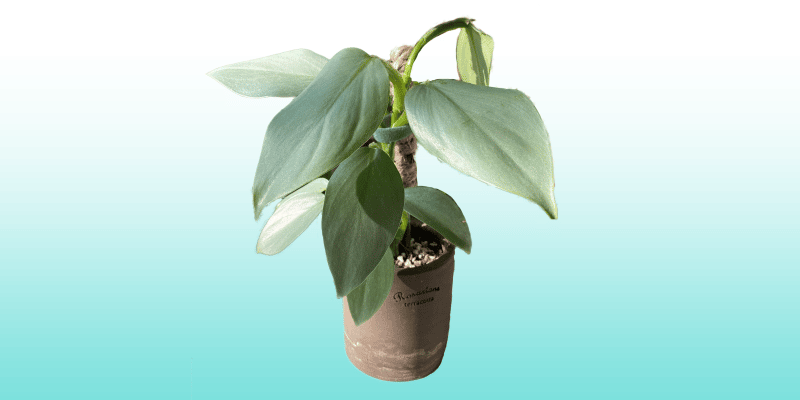You, my friend, now have the pleasure of learning about one of the most beautiful and low-maintenance plants, the Philodendron Silver Sword! Each leaf looks like its namesake silver sword, and they’ve got an arresting silvery sheen that catches my eye every time.
Perfect for hanging baskets or as a trailing accent, this philodendron will ruffle and cascade beautifully as it grows.
Best of all, Silver Sword philodendron care is super easy, especially for such a sophisticated-looking tropical plant. Let’s dive in!
Table of Contents
Silver Sword Philodendron Care Guide
History, habitat, and characteristics
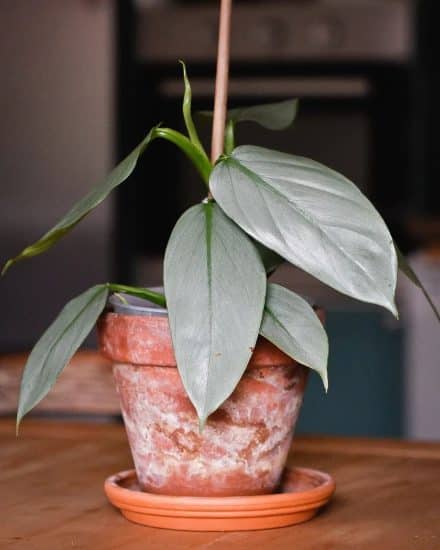
Native to Brazil, Silver sword philodendron, or Philodendron hastatum (its botanical name), is an evergreen perennial aroid that’s part of the Araceae family.
This species has a hemiepiphytic nature, meaning it starts off with its roots in soil. However, as it grows and climbs trees (or moss poles, as the case may be) towards the sun, it evolves into an epiphyte. This means it grows on another plant or surface besides soil and its aerial roots are able to use the air and rain for sustenance. How cool, right?
The philodendron hastatum is an evergreen vining plant with glossy, sword-shaped leaves that display a strikingly metallic silver sheen. In fact, the ‘hastatum’ part of its name comes from the Latin word for spear, ‘hasti.’
As the plant grows, it will evolve into a running vine with lateral branches to become either a climbing vine or trailing plant. Just how big does a silver sword philodendron get? Well, its leaves can reach up to 20″long and 3″ wide, and the plant itself can grow over 10 feet tall.
Because of this, Silver sword philodendron’s thick stems need a bit more support than those of traditional trailing philodendrons.
(Consider giving it a helping hand by attaching it to a moss pole.)
Last but not least, the silver sword philodendron has become an endangered species in recent years due to the destruction of its native habitat. In fact, it’s currently on the IUCN Red List of Threatened Species. Take good care of your philodendron hastum, and you’ll help to preserve it for the future.
Let’s go over the ideal environmental conditions for the silver sword philodendron next.
Light
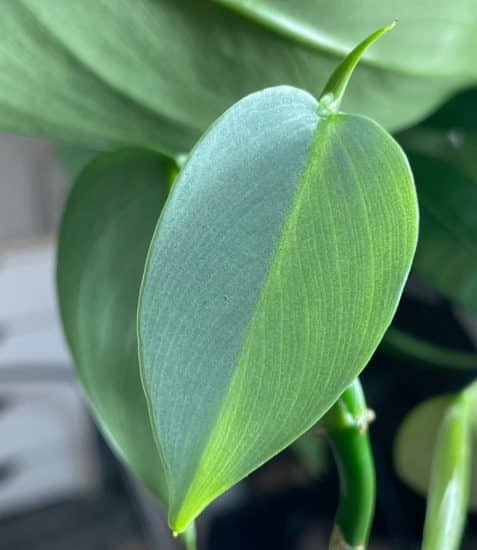
Philodendron hastatum is a jungle plant and thus needs bright, indirect light—never full sun!—to survive indoors. The ideal light level for this plant is at least 1000-1500 Lux and should be measured using a light meter if you have one handy. If not, most smart phones will substitute nicely.
It’s best to place your philodendron silver sword near a window in a room with west or east-facing exposures, depending on the size of the window and the intensity of the light coming in. North-facing windows work too, although they get less bright light. If its environment doesn’t get enough natural light, you can always supplement with artificial grow lights for optimum health and growth.
In a room with bright direct sunlight, like one with a south-facing window, put it at least two to five feet away from a window that gets direct sun to avoid leaf scorch. If this isn’t possible, in order to prevent your philodendron hastatum from getting too much sunlight, try using sheer curtains or blinds.
Water
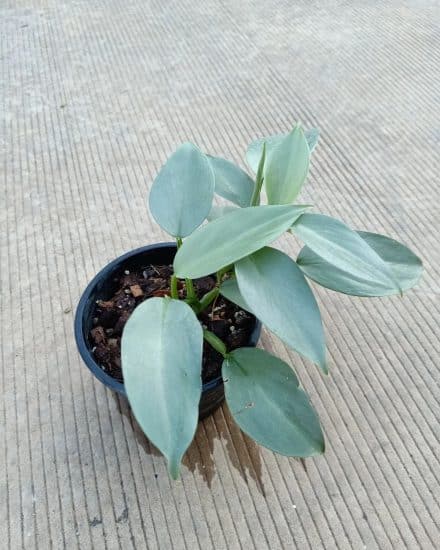
Although philodendron silver swords are tropical plants, aka the moisture loving type, it’s essential to ensure you’re not providing too much or too little water.
You should always check the soil moisture level first instead of watering on a schedule. Probe the top two inches with a finger, and if it feels dry, your philodendron silver sword is thirsty for a drink.
That being said, during the active growing season from spring to summer, you’ll want to water your plant about once every one or two weeks using this method. During the fall and winter months, give your Philodendron hastatum a good soaking about once or twice a month. Like with many other plants, if you’re not sure when to water, a little underwatering is preferable to a little overwatering to prevent rotting roots.
Use filtered, bottled, or rainwater if your tap water contains high levels of chemicals, since your silver sword philodendron is sensitive to chloride, fluoride, and other harmful substances. Make sure to water the soil and not the leaves directly, since you don’t want them to retain moisture that could lead to rot.
Temperature and humidity
These plants are native to the tropical region of Brazil, so if you want your philodendron to grow healthy and strong, you should attempt to replicate the same environment.
Temperature is key to keeping your plant healthy and happy. It grows outside in US hardiness zones 9b through 11. Like Goldilocks, your silver sword philodendron doesn’t like its environment to be too hot or too cold. So, set the thermostat between 65 to 77°F and make sure your Philodendron Silver Sword isn’t close to any heat sources or air conditioning vents.
While this plant thrives in higher humidity levels of up to 80%, it’s likely that you do not. The humidity in the room where you keep your Philodendron Silver Sword should be at least 50% for it to thrive.
If it’s not, you can raise the humidity by:
- Creating a “microclimate.” Cluster similar plants with the same humidity requirements together so their leaves are just barely touching, and they will help humidify each other’s environment. This is a process known as transpiration.
- Creating a pebble tray. Place stones at the bottom of a shallow tray and fill it with water until all but the top of the stones are submerged. Put the plant on top of the stones and allow evaporating water to humidify the environment.
- Misting it infrequently. Mist it with distilled water on occasion to temporarily raise the humidity around it. Avoid going overboard, since overly weight leaves create an unnecessary opportunity for diseases and pests.
Now that you know how to maintain its humidity and temperature needs, let’s get to the real dirt: the best soil conditions for your philodendron hastatum.
Soil and planting
Silver Sword Philodendron soil needs to provide adequate drainage and root aeration, while also retaining moisture. As with other aroid plants, the philodendron hastatum’s soil environment should be slightly acidic to neutral, with a pH of between 6.1 and 7.5, and include plenty of organic matter.
To make an ideal potting mix for your Philodendron hastatum, you actually have a lot of options, too many for most people! Here is an example of a good ingredient ratio, but it’s not the only one you can use:
- 50% Potting soil – provides structure, nutrients, and an anchor for the plant’s roots
- 25% Sphagnum peat moss – keeps soil moist and provides structure
- 25% Perlite, orchid bark, or coco coir – organic matter that helps ensure the soil is aerated and well-draining
- Optional: LECA – helps create air pockets to promote soil aeration and water drainage
You can also consider using a handful of vermicast, or earthworm castings, to enhance the activity of beneficial microbes and help break down soil nutrients. Feel free to throw in some horticultural charcoal as needed, which enriches soil with macronutrients like potassium, calcium, magnesium, and phosphorus, all of which are good for your plant! Be sure to use both of these options sparingly to reduce the risk of over-fertilization.
Fertilizing
Liquid fertilizer can be used to provide more nutrients for your Philodendron hastatum. Use a balanced fertilizer made for indoor plants diluted to half-strength once a month during spring and summer. Don’t fertilize at all during fall and winter, since your silver sword will be dormant at this time and be unable to take up the nutrients.
Pruning
While it isn’t strictly necessary, silver sword philodendron can be pruned if it has any dead or dying leaves, or for a more bushy look. Always use a sterilized pair or pruning shears. Cut right above a node, the bumpy bits on the stem that leaves grow from.
Repotting
This plant does grow quickly, so you’ll likely need to repot it at least once every year, if not more, preferably during the growing season. Use a container with ample drainage holes in the bottom, one or two sizes larger than the previous pot. This will prevent its long stem from overpowering and falling out of the pot as it grows.
When transferring it to a new soil mix, don’t forget to water it generously after. You can also supplement the soil with an organic fertilizer such as worm castings to provide it with extra nutrients during a stressful period.
Ready to get growing? Let’s delve into the different ways to propagate your silver sword.
Propagation guide
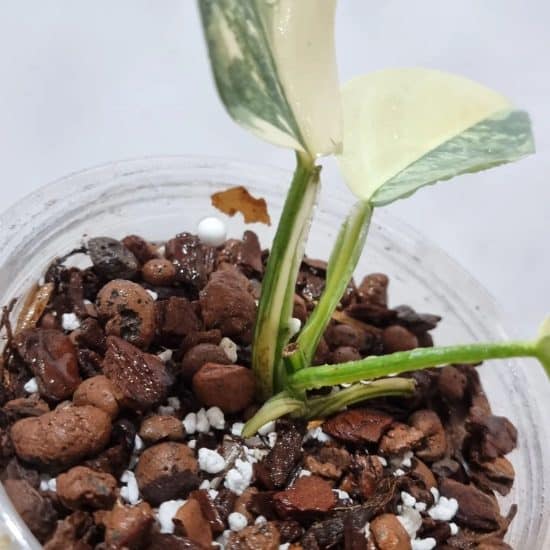
There are three main ways to propagate your silver sword philodendron: stem cuttings in water, stem cuttings in soil, or stem cuttings with sphagnum moss or perlite. Which to choose?
The easiest way to propagate your silver sword philodendron is by stem cutting in water. While cuttings can be planted directly in soil, this method is harder to get right due to the plant’s climbing growth pattern. You’ll have the easiest time going the water route. (We’ll discuss the other methods below).
To propagate silver sword philodendron with stem cuttings:
- Use sterilized, sharp scissors shears to cut off a 6-inch piece of healthy stem with multiple nodes. Cut off the bottom leaves, leaving two to three nodes exposed.
- Place the cutting into a glass of water. The roots will usually develop in the water within a few weeks (and you can watch!)
- Once the roots have grown several inches long, fill a pot with the appropriate soil mix and make a hole in the center. Place your stem cutting into the hole and lightly pack the surrounding soil around it.
- Water the soil gently and set the pot in a warm place with bright, indirect light. Water your new plant regularly, allowing the soil to mostly dry out between watering periods.
You can also root the cutting in sphagnum peat moss or perlite. Doing this takes a few extra steps, but it also reduces the amount of transplant shock when you replant the cuttings from a wetter medium into soil.
To propagate silver sword philodendron by sphagnum peat moss or perlite:
- Use sterilized, sharp scissors shears to cut off a 6-inch piece of healthy stem with multiple nodes. Cut off the bottom leaves, leaving two to three nodes exposed.
- Wet sphagnum moss or perlite and let the excess water drain until they are moist but not sopping.
- Bury the nodes in the damp medium.
- Place the base of the sphagnum moss or perlite into a Ziploc bag to keep it contained while roots grow.
Now that you’re an old hand at propagation, time to discuss the most common issues your silver sword philodendron can have. Droopy leaves? Yellowing leaves? No problem—we’ll figure it out together.
Common issues
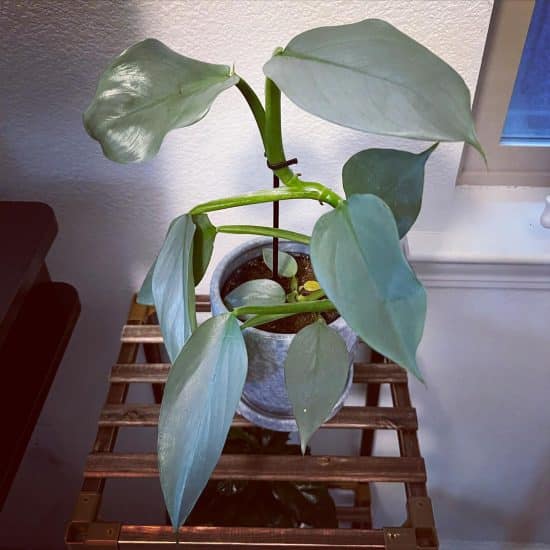
It’s easy to feel overwhelmed by plant care but just think of these problems as speed bumps you can easily overcome. With a little patience, a bit of problem-solving, and lots of TLC, your Philodendron Silver Sword will be thriving in no time!
Yellow leaves. A lack of proper lighting or watering can cause a Silver Sword Philodendron’s normally silvery leaves to turn yellow or suffer from brown tips.
If the leaves are wilting, wrinkling, or curling, then it is more than likely that the plant needs more light. If the leaves are crisping up, yellowing, or developing brown patches, then the plant is getting too much direct sunlight.
Drooping leaves. If you find your plant has wilted or droopy leaves, it could be an indication of either over or underwatering, or a root issue. Check that the drainage holes in the pot aren’t clogged. If the soil is already moist, you may need to increase airflow and drainage in the pot by adding some perlite or vermiculite.
Leggy growth. If the plant is lanky with a leggy stem, spouting new growth far away from the main foliage, and the new leaves are a much lighter color than the older ones, then it’s not getting enough light. It’s etiolating, which means it’s reaching for the sun. Help it out by moving it to a spot with more bright indirect sunlight in easy reach.
Thin or transparent leaves. This could signify nutritional deficiencies, often caused by a lack of nutrients in the soil. If the yellowing is accompanied by wilting of your Philodendron hastatum’s normally silverish leaves, then it might not be getting enough water. Make sure to check the soil moisture level before watering and to fertilize regularly with balanced feeds to keep your plants healthy.
Thin or transparent leaves could also be due to temperature fluctuation or cold water. To avoid this issue, try to find a spot in your home with a more mild temperature, and when watering, be sure to use room-temperature water.
Diseases and pests
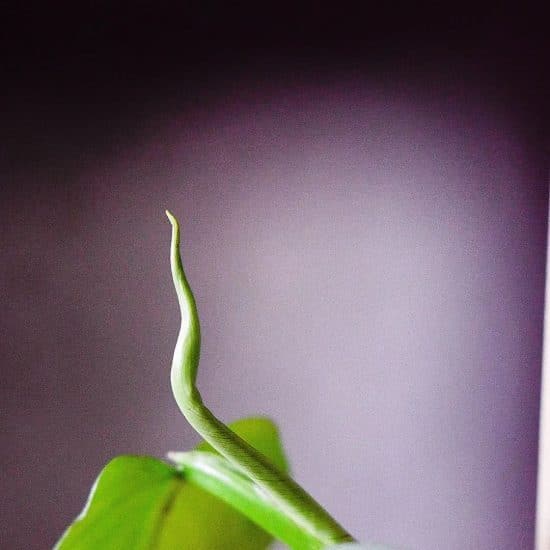
Caring for your Philodendron Silver Sword means watching out for pesky bugs and fungal problems that could be harmful to your plant.
Root Rot. This is a common issue for the philodendron silver sword and is caused by overwatering. Specifically, a number of different fungi from the Phytopthora and Pythium genera colonize in soil that’s too wet, moistening and stressing the roots, which makes the plant more vulnerable to disease.
You can tell if your silver sword philodendron roots are rotting if the leaves turn yellow and start to fall off, or if you see white or brown spots on the roots when you take the plant out of the pot. To treat the issue,you’ll need to isolate and prune the affected roots and repot the plant in clean soil. Make sure to avoid overwatering in the future and think moist, well drained soil.
Fungal Growth. Fungal issues aren’t uncommon with Philodendron Silver Sword plants, but most are treatable with fast action. First, watch out for yellow spots on the underside of its leaves or a stippling pattern: these can occur with excessive moisture. If you do notice fungus, increase the airflow around it by moving it to a brighter, less humid location and treat it with an appropriate fungicide. Avoid overwatering and discard any damp soil, replacing it with fresh soil when repotting. Make sure to isolate it from any other plants around.
Bug Infestations. As with many a plant inside, the silver sword philo can be prone to bug infestations from spider mites, mealybugs, and thrips. If you suspect your plant has been affected, take measures to remove any bugs you find. Spray each stem and leaf surface and underside with a solution of water and dish soap or rubbing alcohol, and gently remove any dust or pests with a damp cloth. Keep an eye out for any webs or small bugs on the leaves, and discard any damp soil before repotting your silver sword philodendron with fresh soil.
Chlorosis. One of the most common issues involving the silver sword philodendron, chlorosis manifests itself as true yellowing of the leaves, where the veins remain green but the leaf itself takes on a yellow hue. It’s due to an iron deficiency from excessive fertilization, or an incorrect soil pH level. This type of yellowing is often mistaken for insufficient light or water levels, which, while they can be a factor in leaf discoloration, are not the only cause.
If a soil test reveals the pH to above 7.0, then apply a fertilizer high in iron to improve the silver sword philodendron’s uptake of nutrients and prevent the leaves from yellowing. If the pH is within normal levels, then put your plant in fresh soil mix and don’t fertilize it as often.
Conclusion
With a head-turning metallic shine, the Philodendron Silver Sword is a wonderful way to bring a little bit of the rainforest into your own home. A climbing or trailing plant, the Philodendron hastatum’s choose-your-own growth style and low maintenance needs make it the perfect houseplant for beginners and experienced green thumbs alike. Give it lots of bright indirect light, high humidity, normal household temps, along with loamy soil that drains well, and it’ll thrive under your touch.
FAQ
Is Philodendron Silver sword hard to care for?
Like other plants, Silver Sword philodendron care isn’t difficult once you know its preferences. It likes aerated, well draining soil, bright indirect light conditions, and a high humidity level.
Is Philodendron silver sword rare?
The philodendron silver sword isn’t a rare plant, since it’s available in many garden stores all over the world. However, it can be considered rare in its own natural environment because of habitat destruction.
Is Philodendron Silver sword toxic?
According to Iowa State University, all philodendron plants are toxic due to the calcium oxalate crystals their stems and leaves produce. So, keep your silver sword philodendron away from small humans and furry friends!

